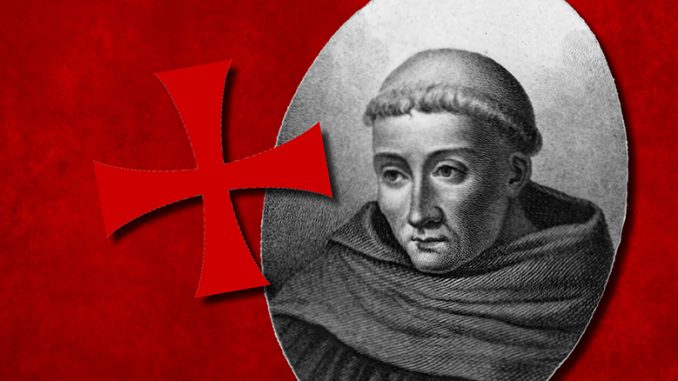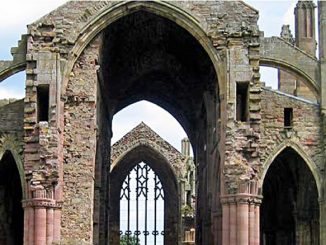
The Council of Troyes © by Alan Butler
We have only scant and sometimes contradictory accounts as to the actual ‘founding’ of the Poor Knights of Christ and the Temple of Solomon. The evidence put forward by Guillaume de Tyre, a later commentator, suggests that it was in the year 1118 that Hughes de Payen, a member of the lesser nobility from Champagne, presented himself, with a number of companions, before the throne of Baudoin II of Jerusalem. After 1118 comes the mysterious period, about which we know so little. What were the embryonic Knights Templar doing in Jerusalem? Were they really intent on keeping the roads clear for pilgrims and if so, why were there only about a dozen of them? Is it possible that they had some other raison d’etre, such as digging below the Temple Mount? This is speculation and represents possible intrigue covered in other articles and it is fair to say that the first genuine date we have for the Templar Order is that of 1128, at which time the Templars officially came into existence.
It is suggested that at some period prior to 1128, Hughes de Payen wrote to Bernard, later St. Bernard of Clairvaux, by this time the leading light in the Cistercian Order and a force to be reckoned with in the Catholic Church. Hughes is supposed to have asked St. Bernard if he would consider sponsoring the embryonic Order and perhaps create a ‘Rule’ for what would be essentially an institution of Holy Knights. It is extremely unlikely that St. Bernard would have needed to be approached officially by Hughes, who was almost certainly known to the little man from Dijon and may indeed have been a kinsman. A much more likely scenario is that the shadowy group of Champagne based nobles who were almost certainly responsible for the formation of the Cistercian Order some years previously, had mooted the idea of the Templars at least as early as 1118. It is suggested that documents found in Seborga in northern Italy virtually prove that St. Bernard at least had a direct hand in forming the Templars.
The story goes that St. Bernard had been responsible for creating a monastery in Seborga, as early as 1113. The same documents are supposed to suggest that Bernard went to this monastery in 1117, in order to release two monks from their vows. These men were Hughes de Payen and Bernard’s own uncle, Andre de Montbard, two of the founders of the Templars. I view these suggestions with more than a little skepticism, mainly born of the fact that Bernard did not enter the monastic life himself until 1113 – so it hardly seems likely that he would be simultaneously creating a new monastery in northern Italy. I intend to research these claims much more fully and hope to report my findings, if any, in a subsequent issue.
However, there is no doubt that, in one way or another, Bernard of Clairvaux, the shining star of monasticism, was prevailed upon to take the embryonic Templar Order under his wing, to regularize it and to seek an official recognition by the Pope. In preparation for the event, Bernard penned a long document entitled ‘In Praise of the New Knighthood’. This was a sort of open letter that justified the existence of a group of monks whose only real existence was to fight and kill others – something that flew directly in the face of all monastic endeavors. It is a mark of respect to Bernard that he not only managed to convince many of his fellow monks that this was an excellent idea, but also the pope.
Bernard’s championing of the Templars was not without opposition. Cardinal Harmeric, a man close to the Pope Honarius II, wrote to Bernard saying “It is not fitting that noisy and troublesome frogs should come out of their marshes to trouble the Holy See and the cardinals.” With customary humor, Bernard defused the critics by a show of humility, virtually demanding that the cardinal ‘order’ him to stay out of papal affairs. By so doing he made the cardinal look rather stupid and, on the way, gained the attention of the pope. Beneath the humility, there was a barbed threat. Bernard was close kin to the ruling house of Champagne – a powerful elite with which the pope would not wish to provoke an argument.
As in all matters to do with the creation of the Templars, there are more questions than answers, but it is a fact that the pope convened a council in Troyes, the capital city of Champagne, in the year 1128. The purpose of this Council was to settle disputes regarding the Bishops of Paris and to deal with other Church matters relevant at the time. Bernard high jacked the Council, using it for his own purposes. How was he able to do this? Almost certainly it was quite easy, since the Council was being held in the heartland of Champagne, only a few miles from Bernard’s own flourishing abbey of Clairvaux. The pope simply could not avoid listening to what Bernard had to say without directly insulting the Count of Champagne.
Bernard had been busy converting the rule of St. Benedict, already adapted for the Cistercians themselves, to a form that would fit the Templar Order. By the time the Pope sat down to convene the Council of Troyes, he was faced with a fete accompli. He simply could not risk offending the rulers of Champagne, who were also blood tied to the kings of Jerusalem. In addition, the apparent intention of the Templar Order probably impressed the Pope, since this armed group of knights, which would certainly grow exponentially, as the Cistercians had done, would be responsible ‘only’ to the pope. With an eye for the future and living in dangerous times, Honorius II might have considered the formation of what amounted to his own private army no bad thing.
As Bernard of Clairvaux was to do on many occasions during his life, he had ’stitched up’ the papacy, ensuring that the Templars would not simply exist, but that they would be headed by factions drawn directly from Champagne and from his own family. The rest, as they say, is history. When Honorius II died in 1130, against all the odds, Bernard managed to have Gregorio Papereschi, a man with a dubious claim at best, elected as Pope Innocent II. This Pope, and his successors, was deep in debt to Bernard, who left no stone unturned to have more and more papal declarations made to consolidate and promote the Templar Order.
However, the Council of Troyes of 1128 was the turning point of early Templar fortunes and could be considered amongst St. Bernard of Clairvaux’s greatest victories.
About Us
We hope you enjoyed this article on the Council of Troyes.
TemplarHistory.com was started in the fall of 1997 by Stephen Dafoe, a Canadian author who has written several books on the Templars and related subjects.
Read more from our Templar History Archives – Templar History

